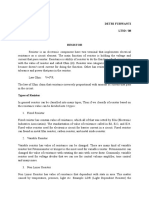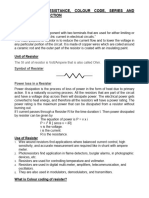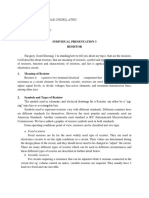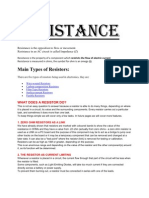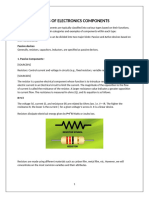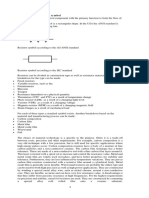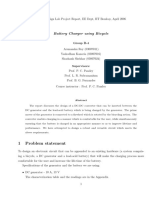Resistor: V I V R
Resistor: V I V R
Uploaded by
Muzakki SathorCopyright:
Available Formats
Resistor: V I V R
Resistor: V I V R
Uploaded by
Muzakki SathorOriginal Description:
Original Title
Copyright
Available Formats
Share this document
Did you find this document useful?
Is this content inappropriate?
Copyright:
Available Formats
Resistor: V I V R
Resistor: V I V R
Uploaded by
Muzakki SathorCopyright:
Available Formats
RESISTOR
1. DEFINITION
Resistor is a passive electronic component that that has a function to inhibit the flow of
electricity in electronic circuits. Resistor has resistive material. Resistance has a unit called Ohm
and has a symbol omega (). According to Ohm's law that resistance is inversely proportional to
the amount of current flowing through. In addition, the resistor also has other values such as
tolerance and capacity are able to pass through.
Based on Ohm Law
V=I*R
The law of Ohm claim that resistance inversely proportional with amount of current that pass in
the circuit.
I=
Whereas:
V = Voltage (Volt)
R = Resistance (Ohm)
I = Current (Ampere)
V
R
R=
V
I
2. TYPES OF RESISTOR
In general resistor can be classified into many types, then if we classify of resistor based
on the resistance value can be divided into 3 types:
1. Fixed Resistor
Fixed resistor has constant value of resistance, which all of that was assigned by EIA
(Electronic Industries Association). Fixed value resistor used for electronics circuit for
barrier current in a circuit. Fixed resistor can found in metal film resistor, carbon
resistor, and metal oxide resistor.
2. Variable Resistor
Variable resistor has value of resistance can be changed. There are many kind of
variable resistor but Potentiometer is the most used for variable resistor. Potentiometer
can changed the value of resistance with rotating the axis with screwdriver. Commonly,
variable resistor used for voltage divider that we can use for control volume amplifier,
tone control and many more.
3. Non Linier Resistor
Non Linier Resistor has value of resistance that depend on the area such as temperature,
pressure, light etc. example LDR (Light Dependent Resistor) the resistance will change
if struck the light, Thermistor the resistance will change if temperature struck that
divided into 2 PTC (Positive Temperature Coefficient) and NTC (Negative Temperature
Coefficient), Strain Gage the resistance will change if pressure struck that, etc.
Then if we classify of resistor based on the material used, can be divided into 3 types:
1. Wire wound Resistor
Wire wound resistor is resistor that made from wire entanglement. So, the value of
resistance determined by long of wire that entanglement. This resistor commonly made
for high power.
2. Carbon Resistor
The main material is carbon charcoal rod. This resistor is most sold and most use for
everyone.
3. Metal Film Resistor
Metal film resistor is a resistor that made from metal oxide. This resistor has better
characteristic than other with lower tolerance like 1% or 2%. This resistor has physical
form like carbon resistor just different color and commonly used for measuring,
industrial and military.
3. READING THE RESISTOR VALUE
The value of resistor can know with color code or text code in resistor. Resistor with the
color code for fixed value resistor with the lower power capacity. And resistor with the text code
for high power capacity and variable resistor.
1. Color Code Resistor
Resistor has 4, 5 or 6 color code. For 4 color code, color 1 and 2 is digit 1 and 2, color 3
is multiplier and color 4 is tolerance. For 5 and 6 color code, color 1, 2 and 3 is digit 1,
2 and 3, color 4 is multiplier and 5 is tolerance. And for color 6 is temperature
coefficient. In sequence of color code is black, brown, orange, red, yellow, green, blue,
violet, gray and white.
2. Text Code Resistor
Resistor with text code can be read easily. Just look at the text on the resistor.
Commonly text code has sequence power capacity, resistance and tolerance. Like 5W
22R J, that shown the resistor has power capacity 5W, resistance 22 and 5% for
tolerance.
4. THE POWER CAPACITY OF RESISTOR
The Power capacity of resistor is maximum power value that can be passed by resistor.
The capacity can be known by look at the physical of resistor or read on the text code of the
resistor. Determining the power capacity is so important to avoid the damage of resistor because
out of limit power capacity make the resistor can be burn. The resistor with the high power
capacity will have big form.
5. THE TOLERANCE OF RESISTOR
If the tolerance of resistor in a range of resistance value, it can be called in good
condition. The tolerance happen because the operational of resistor characteristic is changed. In
resistor, the tolerance shown in 1%, 2%, 5% and 10%. And if the resistor measured and shown
the value out of the range of tolerance that resistor in bad condition
6. APPLICATION OF THE RESISTOR
In real life the resistor has many functions, especially in the electronic circuit:
1. Power electric potential.
2. Minimize the voltage (potential) of electricity. It means that the installation serves to
reduce the power supply voltage from a power source.
3. Reduce electric current. It means that if the installation of a load in a circuit wires, an
electric current flowing into smaller ones.
4. The power supply voltage divided. It means that the use serves to divide the load voltage
from an electric boast, but the result will be equal to the sum of the voltage source.
RESISTOR
Based on Ohm Law :
V=I*R
The law of Ohm claim that resistance inversely proportional with amout of current that pass in
the circuit.
I=
Whereas :
V = Voltage (Volt)
R = Resistance (Ohm)
I = Current (Ampere)
Symbol of Resistors :
V
R
R=
V
I
Fixed Resistor
Variable Resistor
Non Linier Resistor
LDR
(Light Dependent Resistor)
PTC
(Positive Temperature Coeficient)
NTC
(Negative Temperature Coeficient)
Type of Resistors based on Material used :
Wirewound Resistor
Carbon Resistor
Metal Oxide Resistor
Colour Code Resistor :
The application of resistor
You might also like
- Automotive Sensors & ActuatorsDocument108 pagesAutomotive Sensors & ActuatorsSatyaAditham90% (10)
- Resistors PDFDocument12 pagesResistors PDFNdambuki DicksonNo ratings yet
- A Guide to Electronic Maintenance and RepairsFrom EverandA Guide to Electronic Maintenance and RepairsRating: 4.5 out of 5 stars4.5/5 (7)
- Resistor: V I V RDocument8 pagesResistor: V I V Rdafit.setiawan1878No ratings yet
- Materi Individual Presentation ResistorDocument4 pagesMateri Individual Presentation ResistorDetriFurwantiNo ratings yet
- Resistor: Name: Ema Nur Rahmah Class: LT3E No: 09Document9 pagesResistor: Name: Ema Nur Rahmah Class: LT3E No: 09Fariz Aditya PutraNo ratings yet
- What Is A Resistor?: Electrical and Electronic Circuit's The ConductorDocument8 pagesWhat Is A Resistor?: Electrical and Electronic Circuit's The ConductorShivraj GundayyaNo ratings yet
- WE Chapter 1 (Colour Coding of Resistor)Document4 pagesWE Chapter 1 (Colour Coding of Resistor)rahul.1221.mailNo ratings yet
- Familiarisation of Electronic Components and EquipmentsDocument37 pagesFamiliarisation of Electronic Components and EquipmentsKesalan Terasa100% (1)
- Electronic ComponentsDocument6 pagesElectronic ComponentsjungyawarNo ratings yet
- Basic Elec 2Document26 pagesBasic Elec 2Hari100% (2)
- Est Module: 1Document8 pagesEst Module: 1YisobiNo ratings yet
- ResistorDocument12 pagesResistorShantanu ChouguleNo ratings yet
- Types of Resistance: Fixed ResistorsDocument4 pagesTypes of Resistance: Fixed ResistorsFatima SeharNo ratings yet
- Class-8 ResistorsDocument4 pagesClass-8 Resistorsmanyatapatnaik360No ratings yet
- EDC LAB Manual PDFDocument110 pagesEDC LAB Manual PDFAbhishek PathakNo ratings yet
- BEA Lab Experiment 1Document8 pagesBEA Lab Experiment 1Vikas SharmaNo ratings yet
- "Technological University of Altamira": Practice 1Document7 pages"Technological University of Altamira": Practice 1Evelyn Sánchez RomeroNo ratings yet
- Resistor: Group 1: Reactive PowerDocument73 pagesResistor: Group 1: Reactive PowerAlain CopperNo ratings yet
- Resistors 3Document3 pagesResistors 3Incredible IniyanNo ratings yet
- RESISTORDocument7 pagesRESISTOR6qf7yt2sxcNo ratings yet
- RESISTORS Ramesh PDFDocument6 pagesRESISTORS Ramesh PDFDayanand Gowda Kr100% (1)
- Dhiviyansh PunamiyaDocument5 pagesDhiviyansh PunamiyaDhiviyansh Punamiya OT3 - 433No ratings yet
- ResistorDocument24 pagesResistorDiaul AkbarNo ratings yet
- Individual Presentation 3 Resistor: A. Fixed ResistorsDocument3 pagesIndividual Presentation 3 Resistor: A. Fixed ResistorsChoiril AthoNo ratings yet
- MITS - Analog Circuits - FamiliarisationDocument22 pagesMITS - Analog Circuits - FamiliarisationprdpmsNo ratings yet
- Las Q1Document9 pagesLas Q1Gaux SkjsjaNo ratings yet
- Topic 2 (Resistor) : Name: Amelinda Azalia Savira Class: EK-3ADocument3 pagesTopic 2 (Resistor) : Name: Amelinda Azalia Savira Class: EK-3Avira amelindaNo ratings yet
- Experiment 2 Circuit Components Awareness and MeasurementDocument19 pagesExperiment 2 Circuit Components Awareness and MeasurementKOJANo ratings yet
- ResistorsDocument23 pagesResistorstshi06902No ratings yet
- Essentials of Electronic CircuitDocument7 pagesEssentials of Electronic CircuitRam VigneshNo ratings yet
- 3 ComponentsDocument46 pages3 ComponentsedryanNo ratings yet
- Understand Electronic ComponentsDocument83 pagesUnderstand Electronic Componentsfuse125No ratings yet
- ResistorsDocument11 pagesResistorsIX17-41 Suvayu ChatterjeeNo ratings yet
- Bio Ecp Lab ManualDocument55 pagesBio Ecp Lab ManualShubham KumarNo ratings yet
- Lab Manual Edc JntuhDocument92 pagesLab Manual Edc JntuhsfagdfgdfNo ratings yet
- Tran Resi Capa 34Document17 pagesTran Resi Capa 34IX17-41 Suvayu ChatterjeeNo ratings yet
- EEPaper IDocument145 pagesEEPaper IkusumaNo ratings yet
- ResistanceDocument7 pagesResistanceEr Karan AroraNo ratings yet
- Las Q 1 Week 6 Ste 9Document8 pagesLas Q 1 Week 6 Ste 9Ianne PasteraNo ratings yet
- EE-199 L Basic Electrical and Electronics Engineering LabDocument17 pagesEE-199 L Basic Electrical and Electronics Engineering LabEtsham AmjadNo ratings yet
- Lab - 03 Basic ElectronicDocument15 pagesLab - 03 Basic ElectronicchihsanzahidNo ratings yet
- 01 - ResistorsDocument3 pages01 - ResistorsKaushik BhattacharyaNo ratings yet
- Resistor Detailed StructureDocument6 pagesResistor Detailed StructureStemBridge LabsNo ratings yet
- Nothing Special 2Document19 pagesNothing Special 2Jester SubiaNo ratings yet
- Electrical Circuits IDocument22 pagesElectrical Circuits IBryar HusenNo ratings yet
- Components of ElectronicsDocument25 pagesComponents of Electronicsaminshahid866866No ratings yet
- Resistors and Types of Resistors: Whats Is A Resistance?Document3 pagesResistors and Types of Resistors: Whats Is A Resistance?Subas ShresthaNo ratings yet
- Resistors and Types of Resistors PDFDocument3 pagesResistors and Types of Resistors PDFSubas Shrestha100% (1)
- Chap-2-3 not completeDocument14 pagesChap-2-3 not completeabdullahtate3No ratings yet
- Potentiometer - Working, Circuit Diagram, Construction & TypesDocument19 pagesPotentiometer - Working, Circuit Diagram, Construction & Typeskuruvillaj2217No ratings yet
- Resistor Definition and Symbol: o o o o o o o oDocument7 pagesResistor Definition and Symbol: o o o o o o o oGio Lagadia100% (1)
- Study of Electronic Components (1)Document36 pagesStudy of Electronic Components (1)shreehari shindeNo ratings yet
- ECP Practical ManualDocument69 pagesECP Practical Manualjigar16789No ratings yet
- ResistorDocument17 pagesResistorphutd09No ratings yet
- Ebooks Electronics Tutorial About The ResistorsDocument51 pagesEbooks Electronics Tutorial About The ResistorselectrotutsNo ratings yet
- Color Coding and Testing of ResistorsDocument4 pagesColor Coding and Testing of ResistorsRickyNo ratings yet
- 1A.Study of ResistanceDocument3 pages1A.Study of ResistanceshahmukteshNo ratings yet
- What Is A ResistorDocument7 pagesWhat Is A ResistoremilcioraNo ratings yet
- Week 1 Q1Document33 pagesWeek 1 Q1Vinilda MercurioNo ratings yet
- Unit Learning OutcomesDocument1 pageUnit Learning OutcomesAngelica Ulpindo BalubarNo ratings yet
- WR3 Ec1Document10 pagesWR3 Ec1Brent MaraNo ratings yet
- NI Tutorial 3642 enDocument6 pagesNI Tutorial 3642 enronaldxmenNo ratings yet
- TVNVG 3. Voltage Presence Relay On An M.V. Feeder: Commissioning & MaintenanceDocument12 pagesTVNVG 3. Voltage Presence Relay On An M.V. Feeder: Commissioning & MaintenancejjcanoolivaresNo ratings yet
- Manual - Variador DDFF PDFDocument58 pagesManual - Variador DDFF PDFابو القاسم احمدNo ratings yet
- Electronics by Gibilisco QandADocument22 pagesElectronics by Gibilisco QandAMary Rose AtendidoNo ratings yet
- Besic Electrical & Electronics ManualDocument28 pagesBesic Electrical & Electronics Manualberihu aredomNo ratings yet
- Lesson 10Document25 pagesLesson 10Mohammad KhazaalNo ratings yet
- TelegraphDocument9 pagesTelegraphIyappan SivanandamNo ratings yet
- Index: S.N0 Content Page NoDocument15 pagesIndex: S.N0 Content Page Nokanishka.y05No ratings yet
- Conductive Glue and Conductive Thread Make An LEDDocument17 pagesConductive Glue and Conductive Thread Make An LEDRosemary SmithNo ratings yet
- Movement of Sand by Wind by Pierre-Yves Belly.Document102 pagesMovement of Sand by Wind by Pierre-Yves Belly.SorrowduskNo ratings yet
- Battery Charger Using Bicycle: 1 Problem StatementDocument14 pagesBattery Charger Using Bicycle: 1 Problem Statementbenny bullNo ratings yet
- PART 1-Elec BukDocument29 pagesPART 1-Elec BukAdrian BagayanNo ratings yet
- Experiment No.8: OBJECT: To Determine The High Resistance by Method of Leakage of ChargeDocument4 pagesExperiment No.8: OBJECT: To Determine The High Resistance by Method of Leakage of ChargeBhavanshu SainiNo ratings yet
- 7CH4Q45C 7CH4Q90C: - User'S GuideDocument37 pages7CH4Q45C 7CH4Q90C: - User'S GuidePrzemek BiedkaNo ratings yet
- Biffi IS2000Document16 pagesBiffi IS2000Kolbert ArpadNo ratings yet
- Physical Science Teacher GuideDocument28 pagesPhysical Science Teacher GuideJj JjNo ratings yet
- 45RSX2 Speed Control ReallyDocument8 pages45RSX2 Speed Control ReallyejazNo ratings yet
- Obstacle Avoiding Robot CarDocument49 pagesObstacle Avoiding Robot Carhynas abrahamNo ratings yet
- Installation Manual MAS2600Document27 pagesInstallation Manual MAS2600Ketan SarmalkarNo ratings yet
- Vacon NX All in One Application Manual DPD00903C UDocument392 pagesVacon NX All in One Application Manual DPD00903C UMahmoud KhattabNo ratings yet
- A Printed Circuit BoardDocument7 pagesA Printed Circuit BoardmrhailgvnNo ratings yet
- Data Sheet Epn-110dn,-2Document5 pagesData Sheet Epn-110dn,-2roy fadliNo ratings yet
- Arduino Iot Cloud Bootcamp: Building Iot Apps For The CloudDocument7 pagesArduino Iot Cloud Bootcamp: Building Iot Apps For The Cloudabhishekray20No ratings yet
- FMMSDocument28 pagesFMMSAbhishek PareekNo ratings yet
- Ventilator Report EditedDocument31 pagesVentilator Report Editednirajaadithya.dasireddiNo ratings yet
- Verified Analog Parts - LNKDocument3 pagesVerified Analog Parts - LNKAnonymous BW9mIv22NNo ratings yet
- Neptune II CPP Remote Control Systems Scana Propulsion PDFDocument19 pagesNeptune II CPP Remote Control Systems Scana Propulsion PDFAndrei KrivdaNo ratings yet
- P7810C Pressuretrol® Controller: FeaturesDocument12 pagesP7810C Pressuretrol® Controller: FeaturesNebur MtzaNo ratings yet




